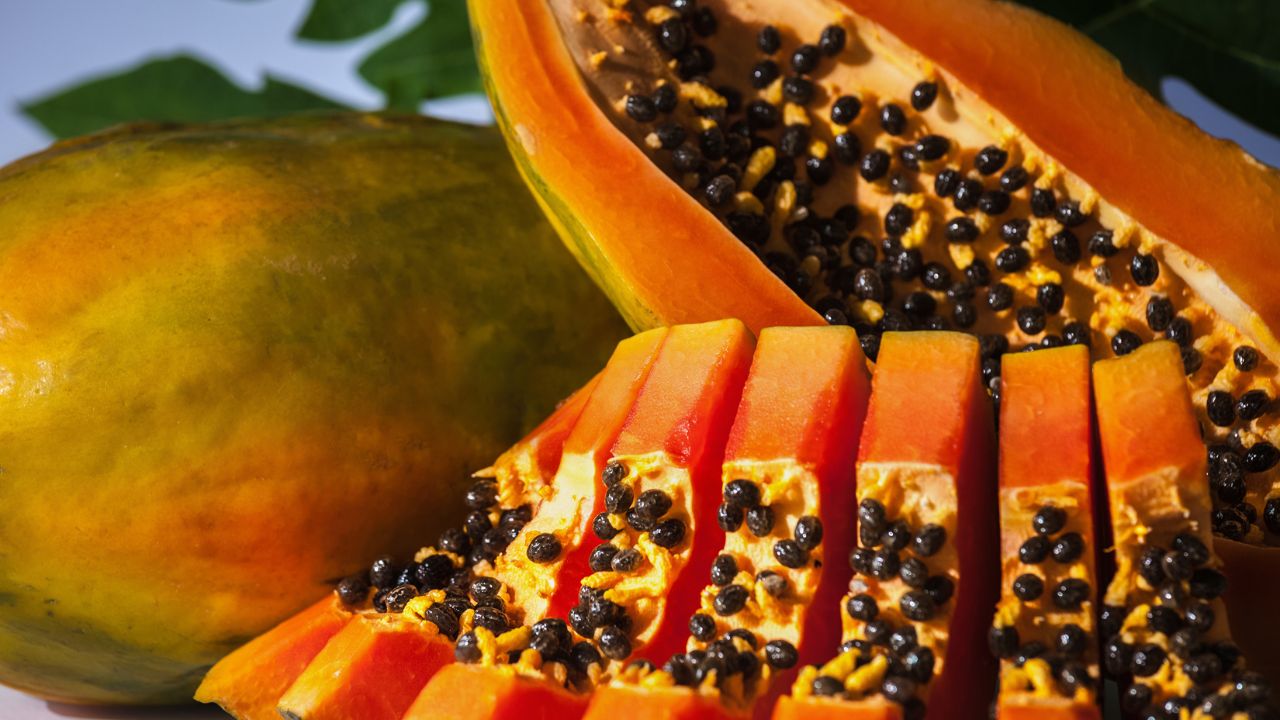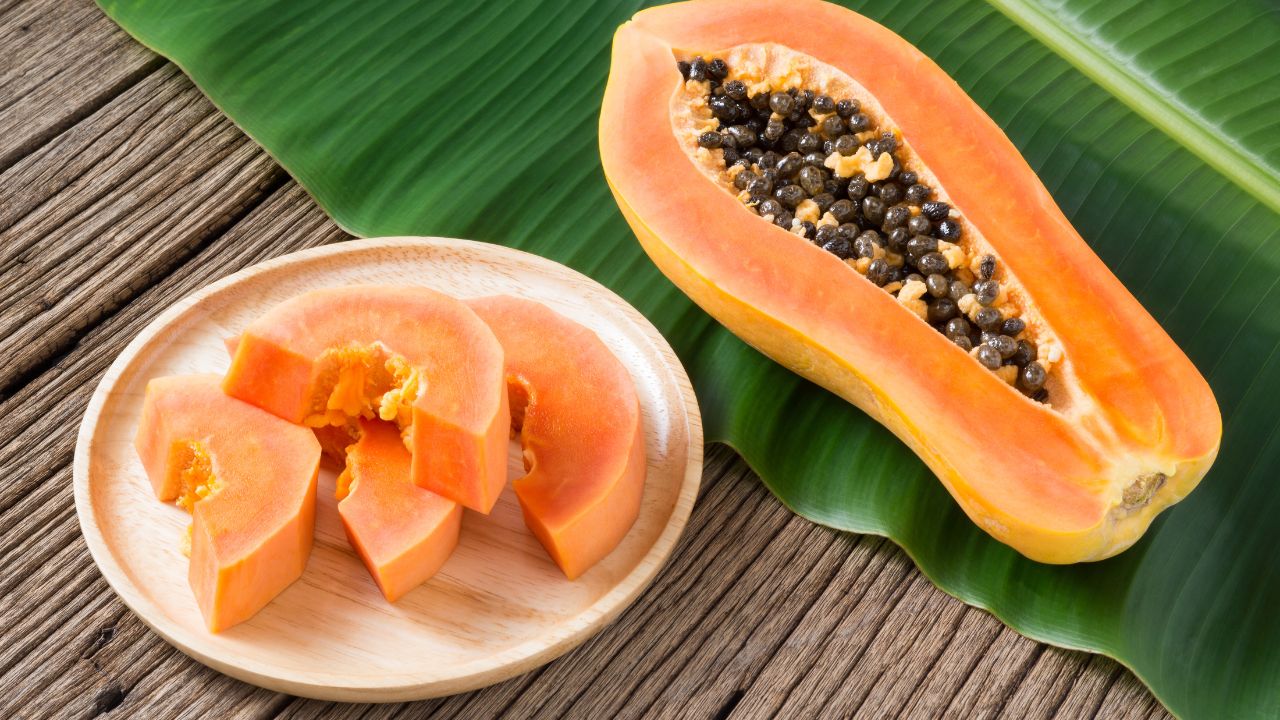You’ve probably seen papayas, a tropical fruit, in the supermarket but never bought any. They have a huge, melon-like size and flesh that is delicious and orange in hue.
You may have experienced it even if you weren’t aware of it because they are frequently used in Caribbean and Asian cuisines. It is not a fruit that many people think of, when they are purchasing their fruits.
Yet, if you need a papaya for a recipe or want to try one. Then you need to make sure that you are purchasing a ripe papaya. In this article, we are going to help you understand when a papaya is ripe.

Health Benefits From Papayas
Tropical regions are the source of some of the healthiest, most nutrient-dense foods that we consume!
Papaya has a number of health advantages, such as the ability to fight cancer and prevent asthma.
Papayas contain the antioxidant zeaxanthin, which blocks dangerous blue light rays. It is believed to protect the health of the eyes and prevent macular degeneration.
People who eat a lot of particular nutrients have a lower risk of having asthma. Papayas include beta-carotene, which is one of these nutrients.
The antioxidant beta-carotene, which is present in papayas, may lower the chance of developing cancer. Beta-carotene-rich diets may help protect against prostate cancer in younger men.
Additionally, mashed papaya seems to be helpful for accelerating wound healing and avoiding burn infection when applied topically.
Along with other antioxidants and nutrients including magnesium, vitamin A, folate, and potassium, papayas are a rich source of vitamin C (for some more delicious Papaya juice recipes, read here).
They also provide papain, a specialized digestive enzyme that helps ease bloating, sensitive stomachs, and even irritable bowel syndrome.
Signs To Look For When Picking Ripe Papayas
Not everyone is fortunate enough to reside in areas where papaya trees are present, but if you are, make the most of it!
The best papayas are those that are eaten right off the tree. However, you can also eat them straight off the grocery store shelf.
You can find the ideal papaya by keeping an eye out for these four simple characteristics.
Color
A ripe papaya should be transforming from a vivid green to a lovely golden yellow in color. A small amount of orange to red hue can also be seen on the skin of some papayas.
When fully ripe, it should be roughly 80% yellow. Green flecks are acceptable; the fruit will continue to ripen at home. We’ll discuss more about this later.
Bruising
Look for bruising and trouble areas. A perfectly ripe papaya may have a few tiny spots, since it grows softer as it ripens. Yet, in general, the surface should be smooth and soft.
Give
When you press your thumb into a ripe papaya, it should give slightly, much like a ripe avocado (see also ‘What Does Avocado Taste Like?‘). To test the papaya’s suppleness, gently push the bigger end.
Like an avocado, overly soft indicates that something is overripe. Avoid the fruit if it is excessively soft around the stem end, as the fruit will be overripe and won’t be as enjoyable to eat.
Scent
Try sniffing the papaya close to the stem if you’re still not sure which one to choose. It should have a slight sweet aroma. If there is no scent, it is not yet ripe.
Nevertheless, if there is a strong, disagreeable smell, it is overripe and likely beginning to ferment.

How Do You Ripen Your Papayas?
Don’t panic if papayas aren’t in season right now or if you only see green ones at your neighborhood supermarket. You can still purchase a green papaya and ripen it at home.
If kept at room temperature, they will keep ripening. Here are some pointers and strategies for ripening papayas at home:
- To prevent bruising, place your papayas on a flat surface. Rotate them every now and then.
- To prevent them from becoming too hot and ripening too quickly, keep them away from direct sunlight.
- Keep them hidden and in a paper bag. As fruits ripen, they all emit ethylene. The fruit ripens more quickly when the natural gas is trapped inside of it.
- An apple, avocado or banana may quicken the ripening process if they are added to the bag with your papaya. This is also brought on by the ethylene that the other fruits emit. If you have a very green papaya, add these fruits, to quicken the ripening process.
- Your papaya might not fully mature if it is all green. By slashing it three times from tip to tip, you can attempt to ripen it. Make sure to fully pierce the skin with a sharp knife and slice into the fruit underneath.
Instead, you could purchase an already ripe papaya. Although, if you want your ripe papaya to keep for longer, then keep it in the refrigerator. They should be used as soon as possible if they are ripe, but they can be stored in the refrigerator for up to a week.
Papaya slices can be frozen and later used in smoothies if you have too much to eat before it spoils.
While discussing how to ripen papayas, it’s worth mentioning that fruits that start with “h” include “huckleberry,” which can be an alternative for papaya, as it has the same powerful digestive aid compounds.
Flavor Of A Ripe Papaya
Compared to other tropical fruits such as pineapples or mangoes, papayas aren’t nearly as sweet.
The texture of a ripe papaya is usually creamy, almost butter-like. This should melt on your tongue and have a cantaloupe-like flavor that is gentle but sweet.
It definitely needs to mature more if there is little to no flavor. Papayas that are still green can still be eaten, although the texture will be gritty rather than smooth.
The seeds are also edible and have a plethora of health advantages. The seeds, however, are not at all sweet. They are typically compared to wasabi or mustard and are bitter and pungent.
Eating A Papaya
A ripe, juicy papaya can be consumed straight away as it is or added to salads, salsas (see also ‘Can You Freeze Salsa?‘), and smoothies. The papaya should be split in half lengthwise, with the sides scooped out.
Additionally, the skin must be peeled off. The papaya can then be melon balled or cut into slices, cubes, or wedges.
If you’re eating it raw, we recommend putting some lime juice over it to bring out its delectable qualities. It tastes fantastic when combined with mangoes, berries, kiwis and passion fruit among other tropical fruits.
We have also added a couple other popular ways in which you can enjoy your papaya.
- Similar to melons (see also our article on the Pepino melon), papaya pairs well with cheese boards and makes a delicious appetizer when it is wrapped in prosciutto.
- Try a fruit salad with papaya, avocado, and grapefruit (see also ‘Pomelo Fruits: Taste, Benefits And Cooking Tips‘) for a variety of tastes.
- For a delicate dessert, cook a green papaya with sugar and cinnamon.
- Along with potatoes, chickpeas, and spices, green papaya is frequently used in savory curry preparations. In addition to that, a delectable Indian delicacy called papite ka halwa is created with papaya, ghee, cardamom and walnuts.
- Papaya seeds can be roasted or dried and used in delicious salad dressings or as a substitute for black pepper.
Where Should You Store Your Papayas?
Keep unripe papayas at room temperature between 68 and 77 degrees Fahrenheit. Depending on the fruit, they will ripen in a couple of days.
It will take a lot longer for green, firm ones to mature than for yellower, softer ones. A daily inspection of your immature papayas is a must.
The ideal storage temperature for fruit once it is ripe is between 54 and 57 °F. The fridge is obviously the second-best choice because the majority of us don’t have a storage place that can sustain such a temperature.
Fruit that is left out at room temperature will ripen too quickly. Furthermore, cut-up papaya should be stored in the refrigerator in a covered container, just like pretty much any other cut fruit.
Overall, your ripe papaya can have a shelf life of anywhere from a couple of days up to a week. As long as they are kept at their optimal temperatures, they will last longer.
While discussing the storage of papayas, it’s worth noting that fruits that start with “y” are relatively rare, with “yellow dragon fruit” being one example. The reason for addressing this fruit is, both papayas and yellow dragon fruit share anti-aging benefits.
Conclusion
Papayas are a great tropical fruit to have now and then. It is a fruit that goes unnoticed by most of us, yet it can be used in various ways. It is important that when you are buying your papaya, you know if they are ripe or not.
By looking at the color and bruising of the papayas along with the odor and texture it has. All these things will let you know whether your papaya is ripe or not.
We have given you all the information on how to tell if your papaya is ripe. In addition, methods to help ripen an unripe papaya you may have brought by mistake. Now you can enjoy these delicious fruits and ripen them to perfection.
- 15 Traditional Greek Breads - July 31, 2023
- 30 Delicious And Gluten-Free Cookie Recipes - July 29, 2023
- 30 Of The Best European Desserts - July 29, 2023
